A few years ago, the Tecno brand meant little to the Russian market. The company arrived here in 2018, but initial success has been modest compared to other regions such as Africa or Southeast Asia. Russian consumers were already accustomed to a wide choice on the market, so Tecno and iTel (another Transsion Holdings brand that entered the Russian market in 2018) were perceived as just two more Chinese companies offering budget smartphones. At the first stage, the company really focused on affordable models, which sometimes differed only in price, without offering anything unique or interesting.
However, the situation changed quickly. The Russian market is not as utilitarian as in other countries, and many consumers prefer to pay more for quality. Tecno quickly adapted to this and revised its strategy to offer better products. The market landscape has also changed in 2022, making Transsion Holdings' products significantly more visible and in demand.
Although all the holding's brands are mainly focused on affordable phones, they are not cheap in the bad sense of the word. For example, Tecno Phantom V Fold cannot be classified as a budget smartphone. It is rather affordable, but at the same time offers good features. The Tecno Phantom V Flip, on the other hand, can be called an affordable foldable smartphone as its price is significantly lower than the average price in this segment.
Price plays an important role for many consumers, and this is reflected even in the choice of new technologies. Tecno strives to remain competitive by offering affordable prices with official guaranteed supplies. This approach allows the company to attract more and more customers, and its popularity is gradually growing.
Next, Tecno plans to expand its range by offering laptops and mini PCs. Even though the laptop market is standardized, Tecno is going to offer its own options, maintaining its strategy of affordable prices and quality products. Cooperation with other companies will also help Tecno quickly enter this market and become a competitive player.
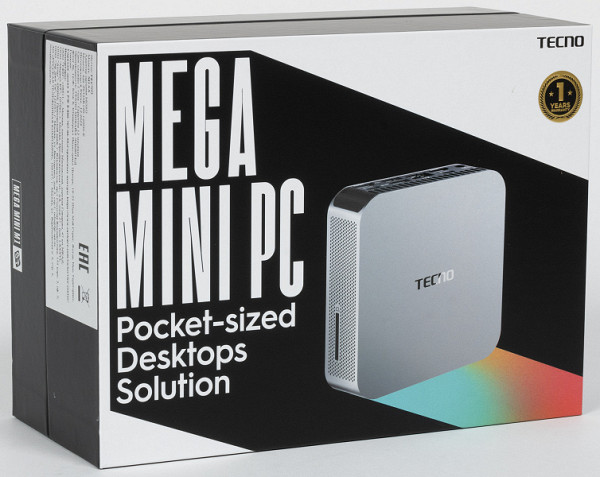
We have already reviewed several of the company's laptops. Today it’s the turn to get acquainted with their mini-PC. So far there is only one model in their assortment, which does not stand out too much from the others. However, in the field of mini-PC design, it is difficult to come up with something revolutionary — Intel set the standard with their NUC. However, this system has interesting features. The name is quite funny: it combines both “mega” and “mini”, as well as some association with M1 processors in Apple devices. The name Mega Mini seems to be the only possible one in this context. Despite the coincidence with the name of the M1 processors, this is rather an accident.
After all, our task is technology, not language. Go ahead and explore the interesting characteristics of this device.
Exterior and scope of delivery
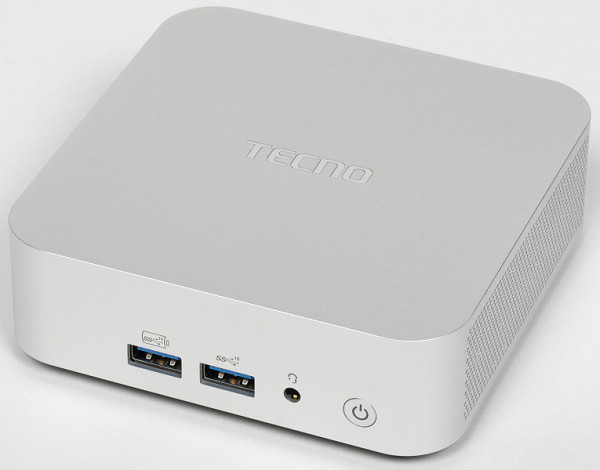
As already mentioned, it is difficult to stand out externally in this segment. Before the first Intel NUCs, all mini PCs had different looks, but they generally weren't very powerful on the inside. Intel presented its vision of this market — a small computer does not have to be slow, and this approach also determined some design directions. For example, the 4x4 motherboard format has become one of the global standards, and now mini-PCs on this basis are produced not only on Intel processors, but also on AMD processors.
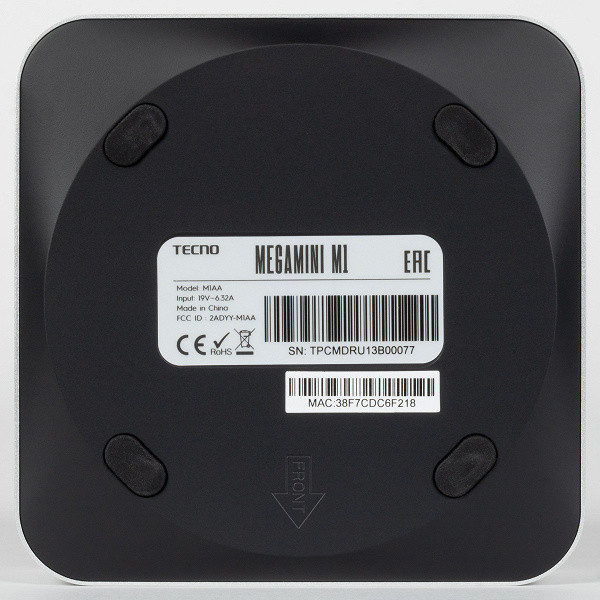
As for the Tecno Mega Mini M1, in terms of the set and location of interface ports, it exactly repeats the Intel NUC model of the twelfth and thirteenth generations. However, this is not the only device with such characteristics. A distinctive feature is the aluminum alloy body — in most similar models, plastic construction predominates, and metal parts are usually of lower quality and functionality. In the case of the Tecno Mega Mini M1, there is only one plastic insert on the back and a plastic cover on the bottom — the rest of the body is cut from a single block of aluminum. This gives the device a very stylish appearance.
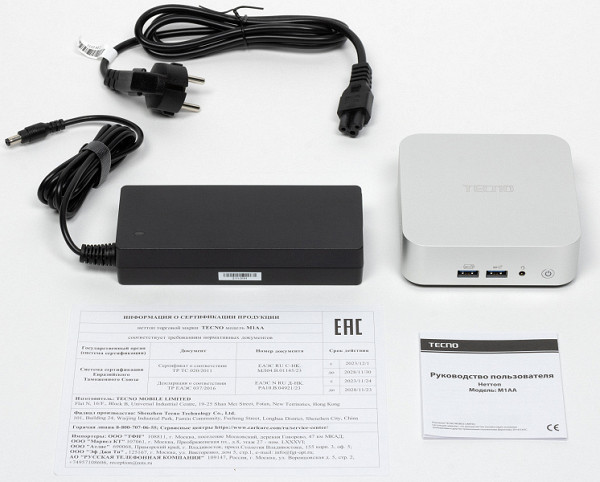
However, there are also some disadvantages. Obviously, it would be wrong to hide such beauty, so the kit does not include the usual elements for mounting a mini-PC on the back of a monitor or TV. For those for whom this is important, you will have to consider other models. The Mega Mini M1 is designed to be a treat for the eyes when standing on a desk. However, the power supply, which is larger in size than the computer itself, does not harmonize well with the overall appearance. Although this is a standard element in this class of devices, it is not to everyone's taste.

The fate of a conventional power supply often comes down to lying under the table, interfering with cleaning. However, the power supply here is surprisingly powerful — 120 W. The computer could probably make do with a smaller, lighter option, but the company seems to be hinting at increased power for the computer itself by using methods such as a larger power supply.
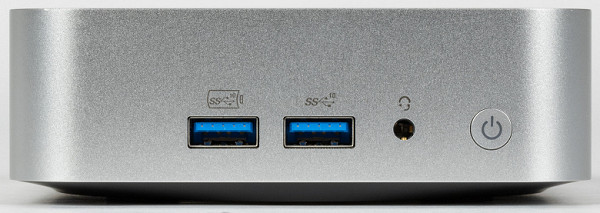
Let's take a closer look at it. On the front panel there are two USB 3.0 Gen2 ports, one of which is also capable of charging mobile devices even when the PC is in the “off” state, a headset jack and a power button. A standard complaint is the lack of at least one Type-C port; preferably with high data rates. But this complaint can be immediately sent to Intel — as already mentioned, everything here is exactly copied from the latest NUCs. Some manufacturers are moving away from basic concepts, some prefer not to take risks.

When you look at the back panel, you come to the same conclusion — there are no changes compared to the NUC. On the other hand, there is nothing to change. There is another USB 3.0 Gen2 Type-A port and a classic USB 2.0, a pair of HDMI and Ethernet at 2.5 Gbps — this is most likely a tribute to compatibility. But two Thunderbolt 4 ports are a tribute to modernity. The company, however, calls them USB4, which is not entirely true, although at the moment there is no difference for the buyer, and in the future it is unlikely to be noticeable. Peripheral makers probably won't risk releasing something exclusively for native USB4 modes while giving up support for the still more common Thunderbolt. But we can't find fault at this point.
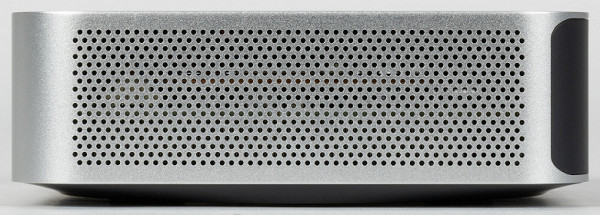
A more serious feature noticed is that both Thunderbolt ports are not designed to power the Mega Mini M1 itself. Although they are suitable for data transfer speeds up to 40 Gbps or video output, you can simultaneously connect up to four 4K resolution display devices with a 60 Hz refresh rate to your computer (or one 8K resolution device with the same frequency), but they do not designed to power the device. This is a much more common practice than the reverse, but it needs to be mentioned. Perhaps someone was hoping to replace the standard power supply with a more compact version that supports USB Power Delivery, or simply connect the mini-PC to the monitor with one cable “for everything,” but this will not be possible.
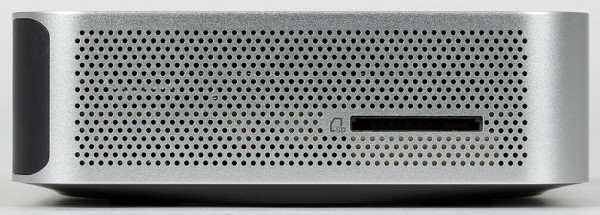
On the left side of the mini-PC there is a familiar element — a slot for full-size SDXC cards. Microcards have become more common lately, so you will need an adapter to use them, but this solution is more universal. In addition, this slot has all the standard functionality. Although it only supports UHS-I, limiting card speeds to around 100MB/s, the fast standards are still not widely adopted. The built-in slot ensures normal performance, which is important as some other devices may have slowed down card handling, for example due to the use of USB 2.0.
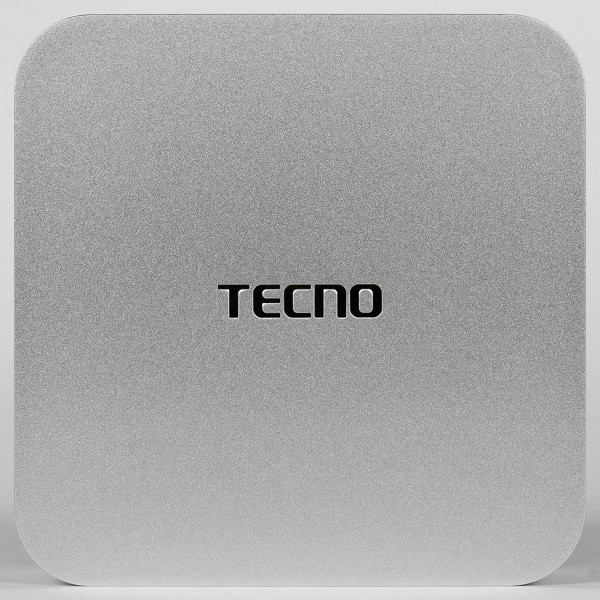
Thus, there are no significant functional differences from most similar mini-PCs. Externally it has an impressive compact aluminum body. However, there are also disadvantages — the Tecno Mega Mini M1 is not designed to be attached to a monitor or TV.
Interior
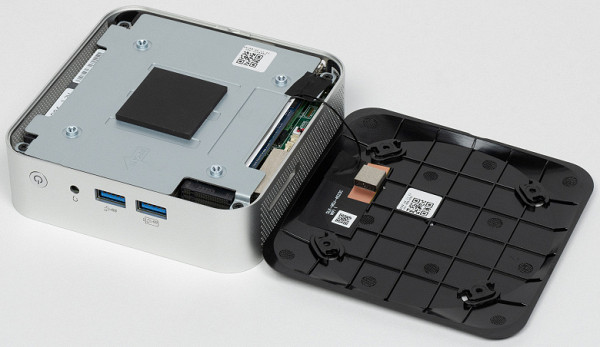
To disassemble the device, you need to tear off the four rubber feet from the bottom and unscrew the four screws hidden under them. After this, the plastic bottom is removed to reveal a metal base underneath. Why this design? Metal makes it very difficult for wireless signals to penetrate, so the antenna must be placed under plastic. In the case of the Mega Mini M1, the best place for this is the top cover. However, the body of the device is almost entirely metal, so there are simply no other options.

We unscrew four more screws, remove the second bottom — and we see a picture that is very familiar in terms of the mass of a mini-PC.

The storage system includes two M.2 slots: one 2280 format and the other 2242. The first supports SSDs with a PCIe Gen4 interface and has a 512 GB Kingston OM8SEP4512N SSD installed by default. This is a fairly cheap solution with a Silicon Motion SM2267XT controller and 144-layer Intel QLC memory, but it is quite suitable for basic tasks. However, if larger capacity or high speed is required, it can be easily replaced with a more powerful option.
The M.2 2242 slot, on the other hand, is not documented. Its compatibility is limited to SATA SSDs only, making it less popular due to its aging format. However, if desired, you can install a second SSD here, for example, Transcend 425S with a capacity of up to 2 TB. Although this is an unofficial solution, it may be useful for storing less meaningful data.

DDR4-3200 memory from Lexar is featured in this mini PC. Although Intel's 12th generation and newer processors support DDR5, manufacturers prefer to stick with DDR4 due to continued compatibility and more affordable prices. In the case of this device, two 8 GB modules provide dual-channel mode out of the box, which has a beneficial effect on integrated video performance.

The wireless adapter slot is hidden under the main SSD, which is standard practice. So it can also be replaced if necessary, but the standard Intel AX201NGW adapter (supporting Wi-Fi 6 and Bluetooth 5.2) will likely last the rest of the computer's life.
We didn't find anything special inside the device — everything complies with industry standards. The undocumented M.2 SATA 2242 slot has attracted some attention, but this is not new, as it can often be found in products from other manufacturers, such as Geekom. However, such a slot is still present on boards from Tecno and other companies.
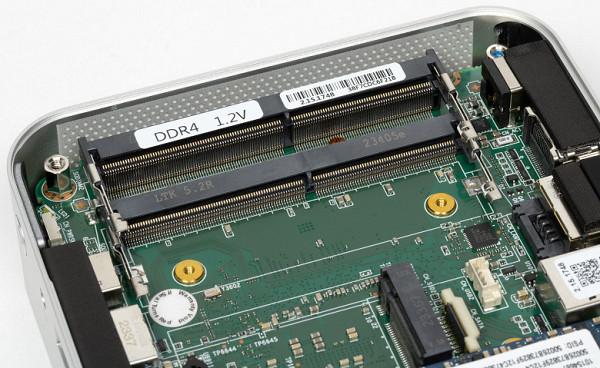
Unlike standard practice for mini PCs, the Tecno Mega Mini M1 does not have a bay for installing two-inch HDDs and SSDs. However, the board has a connector for connecting them. Probably, this compartment had to be abandoned due to Tecno's desire to create a compact and stylish case, as well as due to the use of a double bottom. The first NUC models lacked support for two-inch drives and appeared only in later models based on the Haswell architecture. However, since then the storage market has undergone radical changes, making it possible to abandon this approach without serious consequences.
Hardware configuration
In principle, we have already discussed all the main points in detail above. But a traditional sign won't hurt either.
| Tecno Mega Mini M1 | |
|---|---|
| CPU | Intel Core i5-12450H |
| RAM | 2×DDR4 SO-DIMM 2×DDR4-3200 8 GB Lexar LD4S08G32C22ST |
| Video subsystem | Intel HD Graphics (integrated) |
| Sound subsystem | Realtek ALC256 |
| Drives | 1×SSD M.2 2280 (SATA600 / PCIe Gen4 x4) Kingston OM8SEP4512N 512 GB (PCIe Gen4 x4) |
| 1×SSD M.2 2242 (SATA600) | |
| SDXC UHS-I card reader | |
| Wired network | 1×Intel i225-V 2.5 Gbps |
| Wireless network | Intel Wi-Fi 6 AX201 |
| Bluetooth | 5.2 |
| Front Panel Connectors | 2×USB 3.2 Gen2 Type-A |
| stereo headset jack | |
| Rear Connectors | 1×USB 3.2 Gen2 Type-A |
| 1×USB 2.0 Type-A | |
| 2×Thunderbolt 4 | |
| 1×RJ-45 | |
| 2×HDMI 2.0b | |
| connector for connecting power supply | |
| operating system | Windows 11 Home |
| Dimensions | 112×112×38 mm (0.38 l), 410 g |
| power unit | 120 W 19 V |
It's important to note that the Tecno Mega Mini M1 uses a processor with a 45W TDP, which the company emphasizes in their advertising (they even write: «Unlock real power with 45W performance»). However, taking into account the processor cooling system and the compactness of the case, doubts arise regarding the operation of the processor in this mode. In addition, the TDP level in these models is customizable and can be reduced to 35 W. However, the true power of the processor requires further testing. The remaining characteristics raise fewer questions. The integrated graphics in Intel processors is called modestly, although in fact it is Iris Xe with 80 graphics units, not the maximum 96. For example, the GPU in the Core i5-1240P is also called Iris Xe, and in the i5-12450H it is called HD Graphics. The same i5-1240P processor is almost identical to the Mega Mini M1 in terms of number of cores, threads and GPUs, but has a different TDP level — formally 28 and 45 W, although both are configurable, so testing is required to determine the exact power.
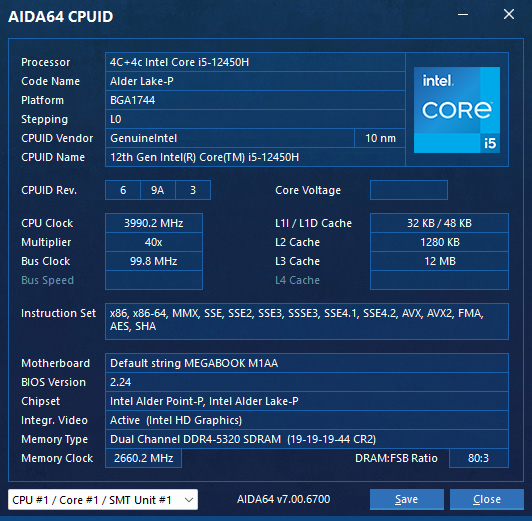
It is important to understand that the twelfth generation of processors is not the final embodiment of technological progress. Specific characteristics and crystals are key here. For example, the i5-1340P represents some improvement over the i5-1240P — more cache and «small» cores. On the other hand, the i5-13420H is very similar to the i5-12450H. For those looking for newness, it may be more pleasant to choose the latest generation, but it comes at a price. From the point of view of consumer characteristics there is no difference between them. A big shift occurred during the transition from the tenth to the eleventh generation of processors, and a small but significant one occurred during the transition to the twelfth. Formally, the latest generation is the fourteenth, but so far there are no suitable processors. Therefore, it is important to focus on specific characteristics, and not just follow the latest innovations.
Performance
To evaluate performance in general tasks, we used our computer system testing methodology, developed in 2020. Test results will be presented in both normalized and natural form. Who will we compare with? The Intel Core i5-1240P mentioned above has already been tested in another mini-PC. Interestingly, the Hiper ExpertBox D20 had exactly the same SSD and the same 16 GB of memory installed, but in single-channel mode. However, the processor's TDP was only 28W, which by today's standards should result in slower performance compared to 45W capabilities. However, this will only become clear in practice.
| Hiper ExpertBox D20 | Tecno Mega Mini M1 | |
|---|---|---|
| Video conversion, points | 105.9 | 115.7 |
| MediaCoder x64 0.8.57, c | 113.30 | 102.39 |
| HandBrake 1.2.2, c | 156.09 | 143.73 |
| VidCoder 4.36, c | 381.71 | 351.59 |
| Rendering, points | 127.8 | 130.4 |
| POV-Ray 3.7, with | 74.77 | 70.17 |
| Cinebench R20 | 90.53 | 92.30 |
| Blender 2.79, with | 127.94 | 127.65 |
| Adobe Photoshop CC 2019 (3D rendering), c | 119.84 | 115.92 |
| Video content creation, points | 170.8 | 199.1 |
| Adobe Premiere Pro CC 2019 v13.01.13, c | 195.49 | 135.68 |
| Magix Vegas Pro 16.0, c | 351.92 | 289.00 |
| Magix Movie Edit Pro 2019 Premium v.18.03.261, c | 51.92 | 54.86 |
| Adobe After Effects CC 2019 v 16.0.1, with | 379.67 | 356.33 |
| Photodex ProShow Producer 9.0.3782, c | 204.02 | 167.82 |
| Digital photo processing, points | 93.4 | 126.7 |
| Adobe Photoshop CC 2019, s | 743.02 | 648.16 |
| Adobe Photoshop Lightroom Classic CC 2019 v16.0.1, c | 155.61 | 96.27 |
| Phase One Capture One Pro 12.0, c | 323.04 | 240.02 |
| Text recognition, points | 128.9 | 127.4 |
| Abbyy FineReader 14 Enterprise, c | 381.53 | 386.09 |
| Archiving, points | 77.8 | 115.3 |
| WinRAR 5.71 (64-bit), c | 614.84 | 348.57 |
| 7-Zip 19, c | 494.41 | 397.07 |
| Scientific calculations, points | 108.7 | 120.2 |
| LAMMPS 64-bit, c | 140.45 | 136.74 |
| NAMD 2.11, with | 155.53 | 139.18 |
| Mathworks Matlab R2018b, c | 62.42 | 61.17 |
| Dassault SolidWorks Premium Edition 2018 SP05 with Flow Simulation 2018, c | 123.00 | 96.67 |
| Integral CPU result, points | 113.0 | 131.3 |
And for clarity, the normalized results are shown in the diagram.

Some tests are sensitive to RAM configuration, so the difference between single-channel and dual-channel mode is noticeable. It's important to note that the company deserves credit for providing two RAM modules out of the box, avoiding the need for an upgrade. If the capacity is sufficient, then 16GB seems like a reasonable choice for a mini PC. However, the difference in the number of processor cores is almost invisible. Why? The answer to this question can be obtained by monitoring the power consumption of the processor, which we also monitor during testing.

Overall, the approach to limiting heat dissipation to 45 W in mini PC cases makes sense given their design. But the emphasis in advertising on this parameter, which seems to imply high performance, raises some questions.
We have not tested gaming performance since it has been known for a long time. Iris Xe, both with a full set of computational units and with a reduction to 80, is a good solution among integrated GPUs. However, this is not the best option for demanding players. Together with AMD Ryzen 5000, it is suitable only for undemanding players who are willing to settle for minimal graphics quality, especially in older games. If you need significantly greater performance, you should consider models with Ryzen 7000/8000 processors or choose a device with a discrete GPU. However, for normal day-to-day tasks, integrated GPUs are more than sufficient, you just shouldn't demand anything extra from them.
Noise level and heating
We measure the noise level in a special chamber with sound insulation and semi-muffling. The sound level meter microphone is placed at a distance of 50 cm from the front panel. The powerMax program is used to create the load, and the room temperature is maintained at 24 degrees Celsius. However, the PC is not specially ventilated, so the air temperature in its immediate vicinity may be higher. To estimate real consumption, we also provide grid consumption data in some modes.
| Load scenario | Noise level, dBA | Subjective assessment | Mains consumption, W |
|---|---|---|---|
| Standby mode | 16.2 (background) | conditionally silent | 2 |
| Inaction | 22.6 | very quiet | 7 |
| Maximum CPU Load | 23.1/33.8 | very quiet/clearly audible | 51 (max 78) |
In general, this computer does not produce significant noise. Even at maximum load, the sound character remains fairly smooth and does not cause discomfort. However, it is unpleasant that with a certain frequency, approximately once a minute, the noise level occasionally increases or decreases. The spectrogram obtained at maximum processor load (at a noise level of 33.8 dBA) has a generally uniform distribution, and no distinct peaks are observed in the frequency range where sounds can be particularly annoying (low-frequency peaks can be neglected).

To subjectively assess the noise level, we use the following scale:
| Noise level, dBA | Subjective assessment |
|---|---|
| Less than 20 | conditionally silent |
| 20-25 | very quiet |
| 25-30 | quiet |
| 30—35 | clearly audible |
| 35—40 | noisy |
| 40—45 | very noisy |
| 45—50 | loud |
| Above 50 | very loud |
Below are thermal images taken after the computer was running for a long time under maximum processor load:
1. Below 20 dBA: The computer is considered silent. The noise level is so low that it is practically inaudible.
2. 20 to 25 dBA: The PC can be described as very quiet. The noise from the cooling system stands out slightly against the background of surrounding sounds.
3. 25 to 30 dBA: The sound from the cooling system does not stand out much compared to the typical sounds of an office with computers running and several employees.
4. 30 to 35 dBA: The noise is clearly audible, but does not exceed a comfortable level for long-term operation.
5. 35 to 40 dBA: The noise becomes more noticeable and exceeds a comfortable level. Masking with background music or other noise reduction techniques may be required to work.
6. 40 to 45 dBA: The computer is very noisy and requires additional noise reduction measures to ensure comfortable operation.
7. 45 to 50 dBA: The noise level becomes very uncomfortable and operation may require the use of headphones or other noise reduction techniques.
8. Above 50 dBA: The noise is so high that it becomes extremely difficult to work without the use of headphones or other noise reduction devices.
The noise scale is arbitrary and may vary depending on the individual preferences of the user and the characteristics of the sound.
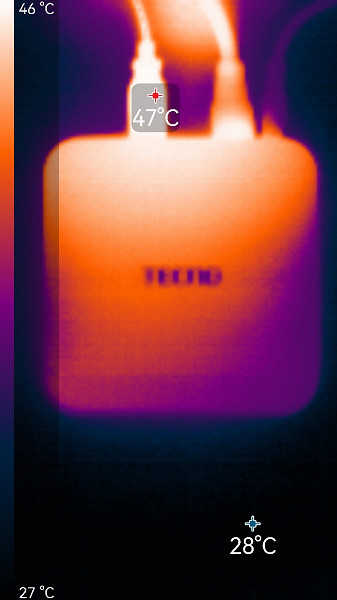
Above

power unit
Under maximum load, the heating of the PC case is moderate, the heating of the power supply is also small, but it is better not to cover it with anything.
Total
There are some comments, but this is an integral part of our work. Any manufacturer has the opportunity to talk about the advantages of their products, but testing should reveal all the nuances, even those that may be kept silent. Sometimes it seems that we are deliberately finding fault, but in fact this is necessary for a complete and objective review.
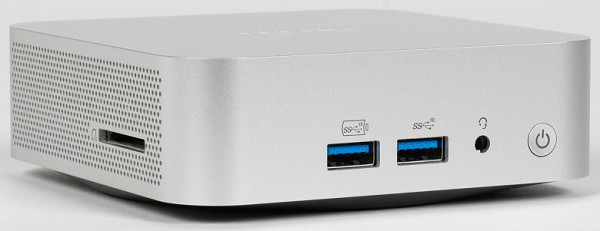
Now let's take a break from the details and evaluate the Tecno Mega Mini M1 in general. In fact, this is an almost complete analogue of the twelfth-thirteenth generation Intel NUC. Intel left the Russian market and then the mini PC market in general, and Tecno is taking its place. Of course, other manufacturers of off-the-shelf computers also do the same, but often depart from the basic concepts, either simplifying or complicating the design for the sake of additional functions. Both approaches have their justification, since buyers have different needs.
However, in the case of the Tecno Mega Mini M1, we see almost complete adherence to the original line. One can argue about the correct choice of specific components, such as the SSD, but in general this allows you to use the computer immediately after purchase, without unnecessary settings and distortions. For example, a pre-installed operating system and two memory modules make it ready to use right out of the box.
In addition, the computer is made in a compact and stylish aluminum case, which is also important. Although it doesn't come with a monitor mount, it looks great on a desktop. So overall, the Tecno Mega Mini M1 is a decent offering in the mini PC market.
